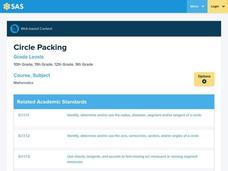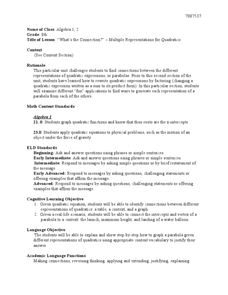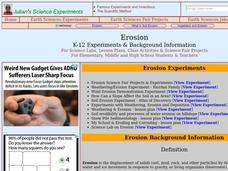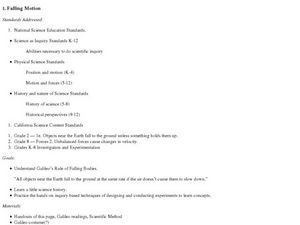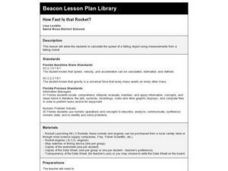Curated OER
Circle Packing
Young scholars identify different parts and properties of circles. In this geometry lesson, students identify the radius, diameter, semicircle and inscribed angle of a circle. They identify the tangent lines to a circle.
Curated OER
Representing Quadratics
Students represent quadratic equations using different methods. In this algebra activity, students solve quadratics using substitution, elimination and graphing. They relate quadratics to the real world.
Curated OER
Convert This!
Students use conversion factors to solve problems. For this algebra lesson, students convert between Metric and English Units. They measure different objects and using both systems in their units.
Curated OER
Don’t Sit Under the Apple Tree…You Might Become Famous
Young scholars explore Newton's laws using CEENBoTs. In this physics instructional activity, students collect data and create tables and graphs. They calculate speed, acceleration and forces using mathematical formulas.
Curated OER
Secondary Robot
Students identify the forces acting on a stationary/constant velocity robot. In this physics lesson, students draw a free body diagrams of the forces. They explain the difference between zero acceleration and zero net force.
Curated OER
Motion in Fluids
Young scholars explore physical science by participating in a science activity. In this liquids lesson, students discuss how fluids can be affected by motion unlike solids. Young scholars define other scientific vocabulary terms and...
Curated OER
History of the Battery
Students study the development of batteries. In this electrochemistry lesson, students compare the different types of batteries. They explore its applications especially in the medical field.
Curated OER
Erosion
Students examine soil erosion and what causes it. In this soil lesson students complete several experiments on soil erosion and the weathering process.
Curated OER
Build Your Own Parachute
Students study the basics of parachuting. For this flight and aerodynamics lesson students make a simple parachute and investigate different variables that can cause potential problems.
Curated OER
The Fall of the Ruler
Students determine their reaction time using a ruler. In this Physics lesson, students calculate the class' means and variances. They plot the graph and analyze if there are outliers.
Curated OER
Falling Motion
Students design and conduct an experiment on Galileo's Rule of Falling Bodies. In this physics lesson, students collect and analyze data. They create a presentation and share it with the class.
Curated OER
IS MASS THE SAME AS WEIGHT?
Students see the difference between weight and mass when they examine the method of measuring each of them.
Curated OER
WHAT HOLDS US TO EARTH?
Students they imagine they are Galileo and try to duplicate Galileo's experiments and results.
Curated OER
Falling
Students should describe the path that the motion would take as well as what might begin or stop the motion. The common characteristic of all the motions that students have experienced directly is that one or more forces are acting on...
Curated OER
Simple Harmonic Motion
Students explain the theory of simple harmonic motion (SHM) by performing hands-on, practical application experiments.
Curated OER
Bounce (Projectile Motion And Collisions)
Students analyze the motion of an object as it moves through a complex path that includes rolling, falling, and bouncing. They answer questions related to what forces are acting at any given time.
Curated OER
WHY DO SOME THINGS FLOAT WHILE OTHERS SINK
Young scholars explore how density can cause things to sink or float by experimenting with a jar, oil and corn syrup.
Curated OER
Avalanche!
Middle schoolers explain that when forces on an object are balanced, the motion of object does not change. They describe how an object changes its motion when forces on it are unbalanced. They plan and conduct a scientific investigation...
Curated OER
How Fast Is that Rocket?
Eighth graders calculate the speed of a falling object using measurements from a falling rocket. They report data from their data sheet to the teacher to record on the board or on the overhead transparency and discuss the results with...
Curated OER
The Buoyancy Factor
Learners examine why some objects float in water while others sink and the ability of something to float does not depend entirely on its weight. Archimedes' principle is introduced and buoyant force is discussed. Practice calculations...
Curated OER
Simple Harmonic Motion
Students study harmonic motion and its oscillation. In this simple harmonic motion lesson students demonstrate a series of regular oscillations and explain the theory behind the experiment.
Curated OER
Virial Theorem Lesson
Ninth graders describe how equilibrium can occur as the balance of two effects. They model the stability of elliptical galaxies based on how fast stars within the galaxy are moving.
Curated OER
Drops on a Penny
Eighth graders experiment to determine the number of drops of water a heads up penny hold. They create a stem and leaf graph of the class results and use the data for further experimentation on a tails up penny.
Curated OER
Plotting the Petroleum Plume
Eighth graders examine the difference between confining layers and aquifers in a basic water table aquifer scenario. They contour groundwater elevation and petroleum product thickness data.
Other popular searches
- Gravity Tides
- Force of Gravity
- Center of Gravity
- Gravity Science Experiment
- Science Project Gravity
- Law of Gravity
- Friction and Gravity
- Planet Orbit Gravity
- Force and Gravity
- Specific Gravity
- Elementary Science Gravity
- Center of Gravity Activities


